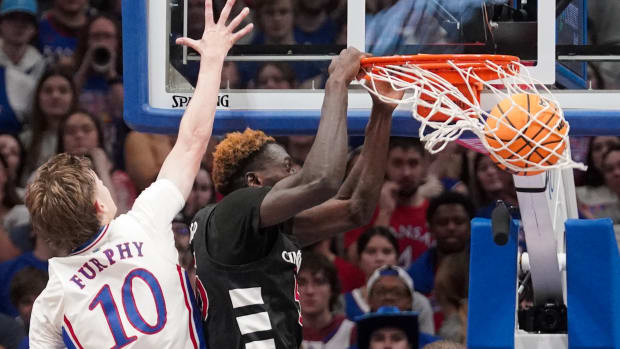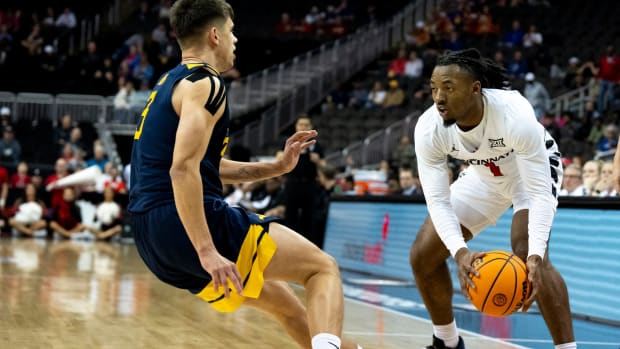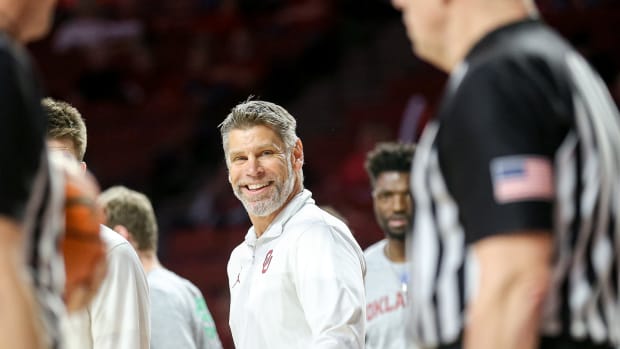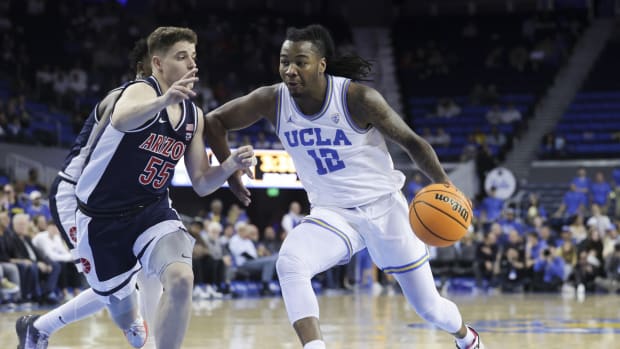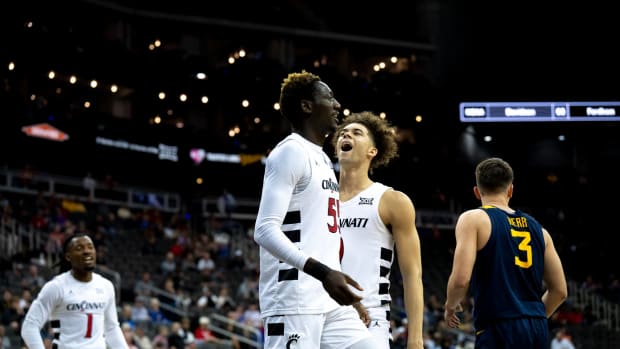Can anybody stop Kansas's offense? The numbers indicate it'll be tough
KANSAS CITY, Mo. — At this stage of the postseason a year ago, Bill Self felt his Kansas team could not have been better prepared mentally. The Jayhawks had won three NCAA tournament games by an average of 18 points. They had fostered a delicate balance between playing loose and playing on edge. And then came the Elite Eight, and Villanova. “We weren’t a confident offensive team down the stretch in that particular game,” Self said Friday, recalling the 64–59 loss. “You look at it—what could we do different to put our guys in better situations, and that kind of stuff.”
A team riding a frighteningly efficient attack ended Kansas’s season last March. And this seemed like a good plan for Kansas to follow this March.
The Jayhawks have played some of their most bracing offense through three NCAA tournament outings, calling to mind a strikingly similar spree that carried Villanova to a national championship last spring. A team fueled by a veteran backcourt performing at a high level … a team effectively deploying four wing players around one big man … a team relying on the three-pointer as a primary weapon … a team overwhelming opponents with scoring from all five spots on the floor…Kansas couldn’t beat that a year ago. So, in many senses, it became that.
Behind Frank Mason, No. 1 Kansas finds killer instinct in rout of No. 4 Purdue
“Everybody is being aggressive,” Jayhawks guard Devonte’ Graham said. “Not just me, Frank [Mason III], Josh [Jackson]. I feel like the guys are coming off the bench giving us key sparks in key moments. We’re all in attack mode.”
It’s an inauspicious trend for Oregon, which on Saturday must attempt to stifle a hyper-effectual No. 1 seed that is following a championship formula fresh in everyone’s minds. It begins somewhat anecdotally: A conference tournament defeat for both—TCU for Kansas in the Big 12 quarterfinals, Seton Hall for Villanova in the Big East championship—triggered an urgency for the trip through the NCAA tournament field. The Jayhawks have been more jet-propelled along that path; they’re averaging 71.7 possessions in their tournament games so far, whereas Villanova averaged 64.7 possessions in their first three NCAA outings in 2016. But this is maybe a distinction without a difference. They ended up in the same place anyway.
In its first three NCAA tournament games last year, Villanova averaged 1.366 points per possession. Its offensive ratings in those games, respectively: 130.9, 125.9, 157.0.
In its first three NCAA tournament games this year, Kansas has averaged 1.340 points per possession. Its offensive ratings in those games, respectively: 133.1, 128.4, 140.9.
Both teams’ offenses surged at the most critical moment. Kansas’ NCAA tournament offensive efficiency numbers represent three of its top five performances of the entire season. While Villanova was more consistently dangerous during 2015–16, its efficiency rate against Miami in the Sweet 16 (the 157.0 figure) and Oklahoma (151.7 in a national semifinal win) represented its top two performances of the year. And both teams employed the three-pointer frequently and with good effect: Shots from beyond the line represent 38.4% of Kansas’s attempts during this tournament. Entering the Elite Eight a year ago, Villanova was at 38.3%.
Tyler Dorsey lifts Oregon in thriller over Michigan to advance to Elite Eight
Stylistically, at least relative to past performance, this is all a greater departure for Kansas than it was for Villanova. But months ago, the Jayhawks coaching staff recognized that its best lineup featured 6’ 8” freshman Josh Jackson as a de facto power forward who plays on the wing, with 6’ 10” senior Landen Lucas the only true post presence on the floor. The comparisons to Villanova’s title-winning starters— four shooters around 6’ 11” center Daniel Ochefu—are not overly superficial. And this has proven to be an effective way to dismantle tournament opposition for two years running.
“Bill has a way of getting the best out of each team,” Oregon coach Dana Altman said. “He’s flexible enough that if the personnel is a little different, he can change his style, and he has with this team. I mentioned [they’re] not running as many sets and not looking high-low as much, and [they’re] a lot more perimeter-oriented than some of his other ballclubs have been. But they’re always going to be disciplined, well-schooled and they know what they want out of each defensive and offensive possession.”
Kansas spent Friday regurgitating the standard defense-first bromides, wary of what might occur if Oregon somehow gets hold of the emergency brake and yanks it back. Villanova, after all, registered its lowest offensive efficiency figure of the tournament—98.3—in that Elite Eight matchup with the Jayhawks.
But no one has come close to halting the Jayhawks’ blistering pace. “I don’t know how we can play much faster,” Self said. And no one has come close to flummoxing Mason III, who is super-charging Kansas’ run by averaging 24.5 points in his last six games. The senior point guard’s offensive rating of 178 against Purdue in the Sweet 16 was his second-highest of the year. “Frank Mason has had the best college season of anybody I've been around by far,” Self said.
In this spot a year ago, Kansas jackknifed against the Elite Eight barrier it has passed just once since 2008. Will this stretch of offensive overdrive help the Jayhawks crash through to the Final Four? Well, it worked a year ago for the team that eventually hoisted the trophy in Houston. And as the Jayhawks were one of Villanova’s victims along the way, the solutions for new championship stratagems was clear: If you can’t beat ’em, purloin ’em.
